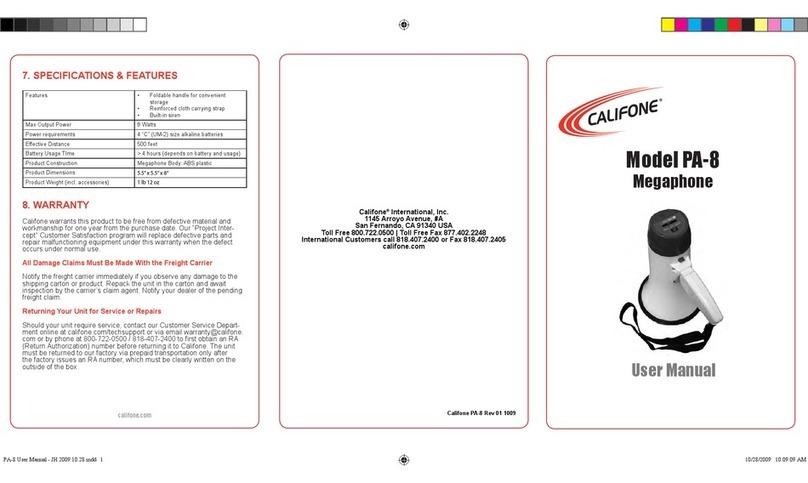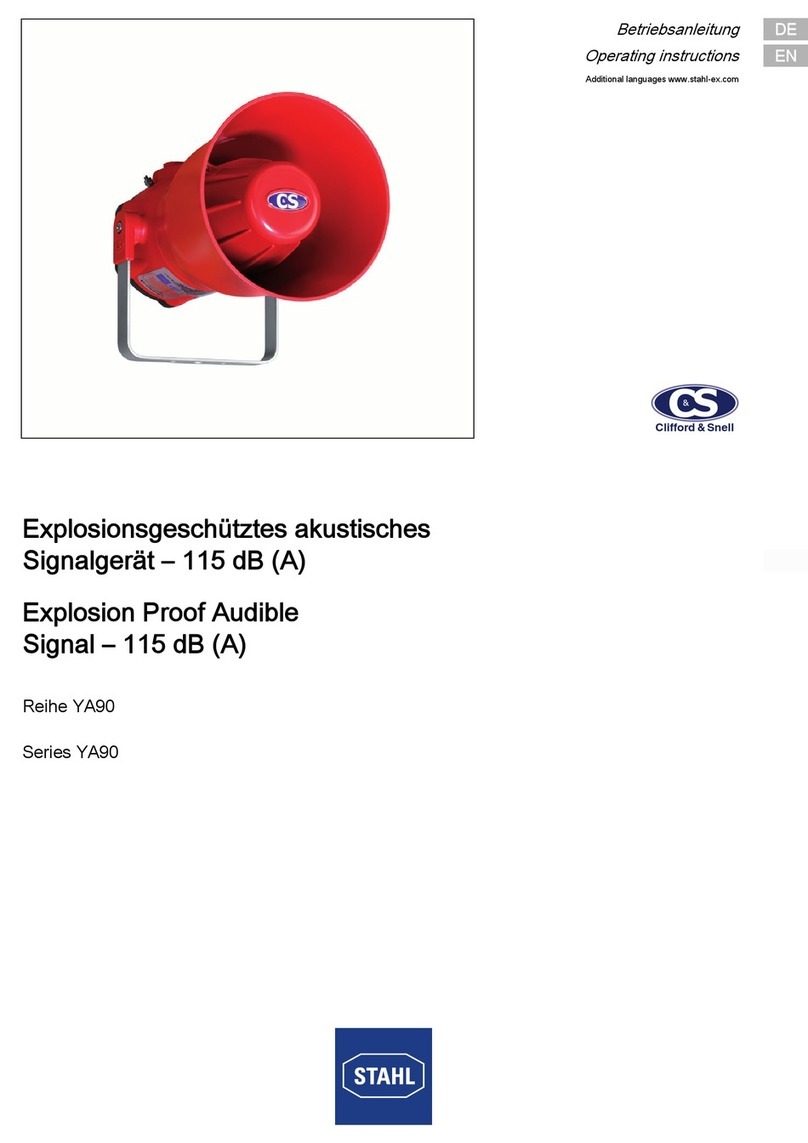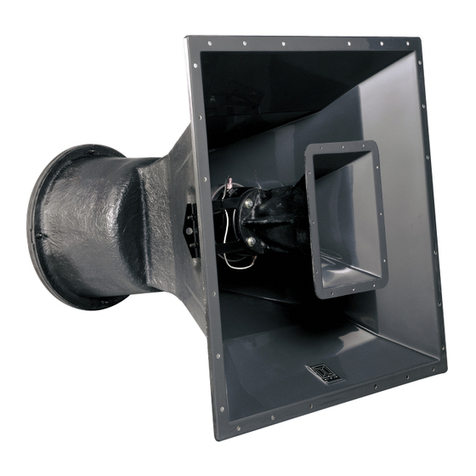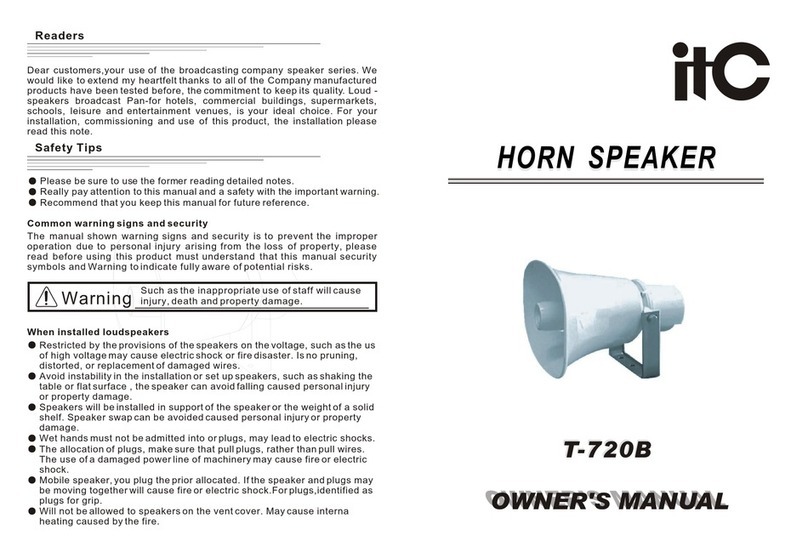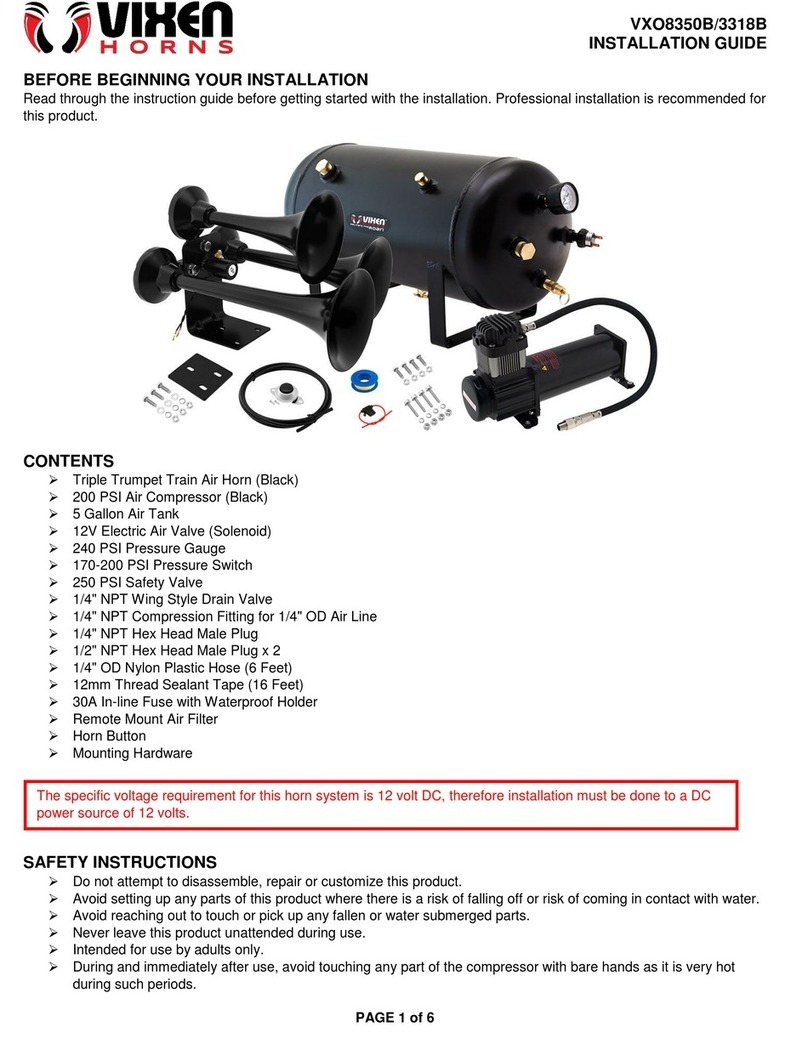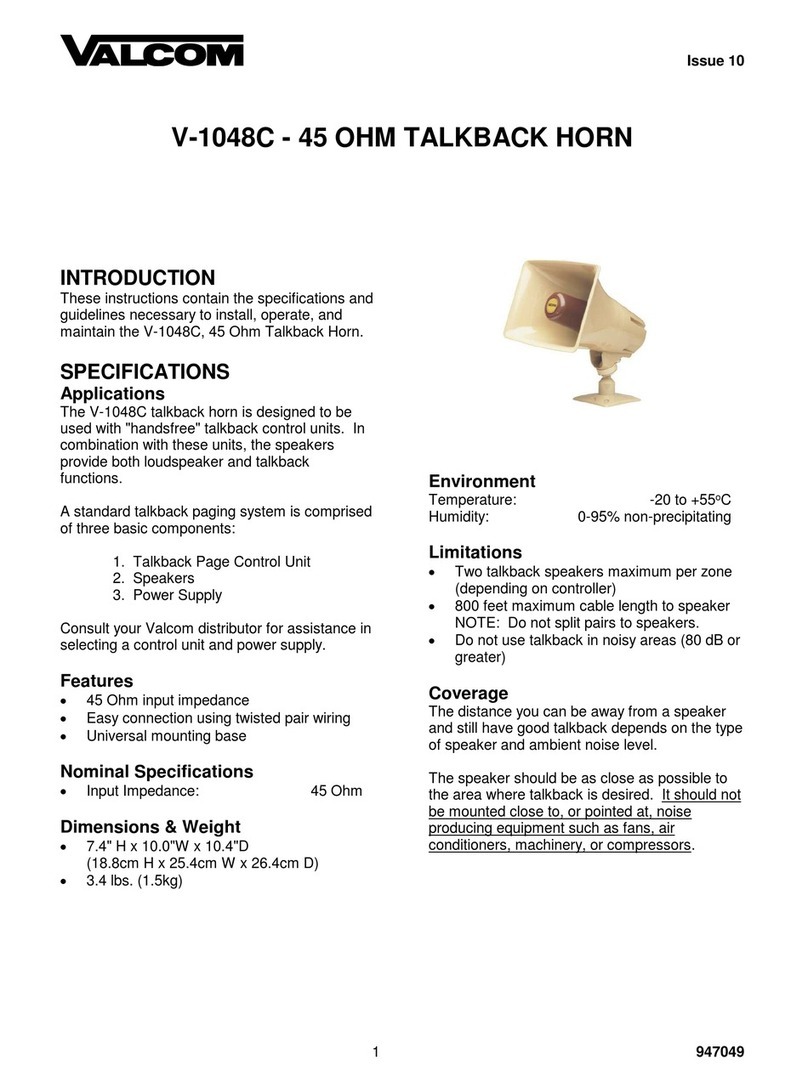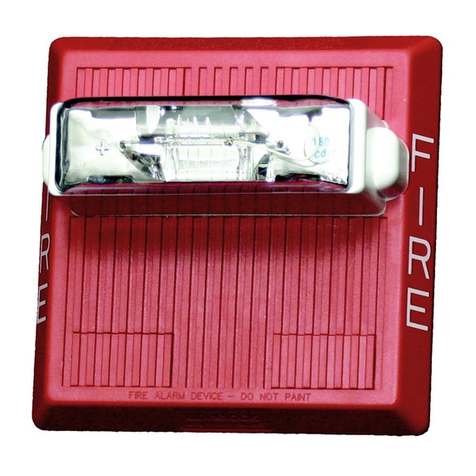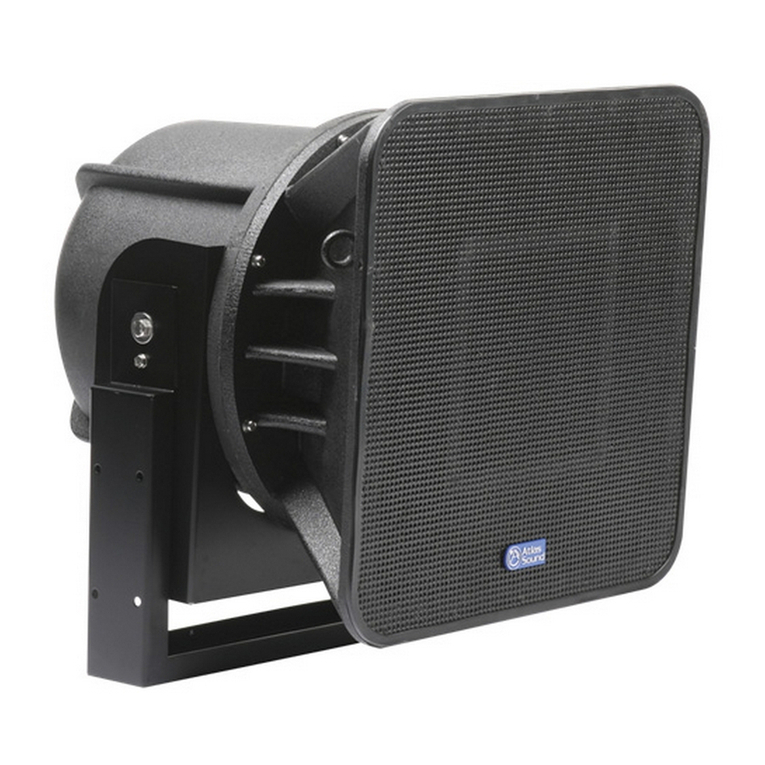BENDIX AIR HORNS AND VALVES User manual

1
®
Air Horns and Valves
SD-06-130
DESCRIPTION
Thepurposeofourairhornistoprovideawarningsignalof
greater volume and farther carrying qualities than usually
foundonautomotive vehicles. The horn isdesignedon the
principleofa vibrating diaphragm. The hornconsistsof die
castbodies,diaphragms,andtwochromeplated horn bells,
with the bells in a horizontal position.
Two types of operating valves are commonly used, the
foot-operatedhorn valveandthehand-operated hornvalve.
Eachofthesevalveshaveabuilt-instrainer.
OPERATION
The horn is operated by pulling down on the lever of a
hand-operatedhorn valve or pushing down on the button of
the foot-operated horn valve. This action pushes down on
thesupplyvalvesteminthehornvalve andopens thesupply
valve.
Whenthesupplyvalveinthehornvalveisopened,airpasses
through the horn valve and enters the cavity in the air horn
onone side ofthediaphragms.Asthe air pressurebuildsup
onthediaphragm, it deflects it and theairescapes through
thehornbells.Thisactionsetsupavibrationofthediaphragm
ineach hornbell.Thetwo different lengthsofhornbells give
the horn its dual tone. The vibrations are set up in an air
column denser than atmosphere, due to escaping
compressed air, which provides unusual tone carrying
qualities.
PREVENTIVEMAINTENANCE
Important: Review the Bendix Warranty Policy before
performinganyintrusivemaintenanceprocedures.Awarranty
maybe voided if intrusive maintenance is performed during
thewarranty period.
No two vehicles operate under identical conditions; as a
result, maintenance intervals may vary. Experience is a
valuableguide in determiningthebestmaintenance interval
for air brake system components. At a minimum, the air
horns and valves should be inspected every 6 months or
1500 operating hours, whichever comes first, for proper
operation. Should the air horns and valves not meet the
elements of the operational tests noted in this document,
furtherinvestigationandserviceofthevalvemayberequired.
TESTING FOR SERVICEABILITY
OPERATINGTEST
1. Withairpressure in the system,operate the horn valve
and the horn should give a loud, clear dual tone horn
blast.
LEAKAGE TEST
1. Withhornvalve in the released position,leakageat the
delivery port or at the valve stem at the top of the horn
valveshould not exceed a 1”soapbubble in 5 seconds
(100SCCM).
2. With the horn valve applied, leakage at the stem at the
topofthehornvalveshouldnotexceed a1”soap bubble
in 5 seconds (100 SCCM).
REMOVING
Toremove the airhornorhorn valve;
AIR HORN
1. Disconnect the air line to the air horn.
2. Removeair horn mountingnutandremovehorn.
HORN VALVE
1. Drain air brake system.
2. Disconnectairlines to the horn valve.
3. Removemountingboltsandremovehornvalve.
INSTALLING
Toinstall an air horn or airhornvalve;
AIR HORN
1. Mounthornontop side of vehicle roof or underhood.
2. Securely bolt horn on a flat surface and use care to be
sure the body is not distorted.
3. The horn bells should point down slightly for adequate
draining.
4. Install at least 1/4" O.D. tubing to the air horn.
HORNVALVE
1. Mountthevalveinthecabwhereitcanbeeasilyremoved
forservicing.
2. Mountsothatpull-cord for the hand-operated valve will
bewithineasyreachofdriver.
3. Mount the foot-operated valve on floor in a convenient
locationfordriver’sleftfoot.
4. Connectairlinestothe horn valve.

2
DISASSEMBLY
AIRHORN
1. Removetheeightnutsandboltsholdingthetwocovers
to the body.
2. Removethediaphragmsfromthebody of the air horn.
3. Remove the spring contact, springs, and spring
assembliesfromthe covers of air horn.
4. Removethehornbellsfrom the body.
HORNVALVE
1. Removethe spring cage from the valvebody.
2. Removethevalve stemfromthevalve body.
3. Removethestrainerandspring from the spring cage.
CLEANING AND INSPECTION
AIR HORN
1. Wash all metal parts in cleaning solvent.
2. Carefullyinspect the diaphragmstobesure they arenot
cracked, deteriorated, or distorted in any way. If ridges
orcracksare found, the diaphragms mustbe replaced.
3. Inspect condition of the body. Be sure diaphragm seat
in body is not chipped or damaged in any way. Check
forcracksinthebody.Iftheseconditionsprevail,replace
body.
4. Inspectcondition of the covers. Besurediaphragmseat
in cover is not chipped or damaged. Inspect the cover
forcracks.Ifthese conditions prevail, replace covers.
5. Inspect the horn bells. If they are cracked or broken,
theyshouldbe replaced.
6. Inspectthespring contacts. If distorted ordeteriorated,
theyshouldbe replaced.
7. Checkthespring. If broken, replace.
HORN VALVE
1. Inspectsupplyvalveand seat. If damaged, they should
berepaired or replaced.
2. Checkthespring. If broken, replace.
3. Be sure the valve stem does not bind when inserted in
thevalvebody.
ASSEMBLY
NOTE: When using pipe thread sealant during assembly
andinstallation, take particular care topreventthe
sealant from entering the valve itself. Apply the
sealantbeginningwiththe secondthreadback from
theend.
AIRHORN
1. Place the diaphragms in the body.
2. Install the spring contacts, springs, and spring
assemblies to the covers.
3. Install the eight bolts and nuts, attaching cover to the
body.Care should be usedtobesureequal pressure is
exertedonall the screws holding thecover to the body.
4. Assemble the horn bells to the body.
HORNVALVE
1. Insertthevalvesteminthevalvebody.
2. Place the strainer and spring in the spring cage.
3. Assemble the spring cage to the body.
TEST OF REBUILT AIR HORN AND HORN VALVE
Both operating test and leakage test must be made after
rebuildingorrepairinganairhornorhornvalve.Iftheairhorn
doesnot operatesatisfactorily,adjustmentofthe springload
behindthe diaphragm can be madebyturningtheadjusting
screw in the cover. Before attempting to turn the adjusting
screw,loosentheadjustingscrewlocknut.Besure totighten
the adjusting screw lock nut after any adjustment.
WARNING! PLEASE READ AND FOLLOW
THESE INSTRUCTIONS TO AVOID
PERSONAL INJURYOR DEATH:
When working on or around a vehicle, the following
general precautions should be observed at all times.
1. Park the vehicle on a level surface, apply the
parking brakes, and always block the wheels.
Always wear safety glasses.
2. Stop the engine and remove ignition key when
working under or around the vehicle. When
working in the engine compartment, the engine
should be shut off and the ignition key should be
removed. Where circumstances require that the
enginebe in operation, EXTREME CAUTION should
be used to prevent personal injury resulting from
contact with moving, rotating, leaking, heated or
electrically charged components.
3. Do not attempt to install, remove, disassemble or
assemble a component until you have read and
thoroughly understand the recommended
procedures. Useonly the proper tools andobserve
all precautions pertaining to use of those tools.
4. If the work is being performed on the vehicle’s air
brake system, or any auxiliary pressurized air
systems,make certainto drainthe airpressure from
all reservoirs before beginning ANY work on the
vehicle. If the vehicle is equipped with an AD-IS™
air dryer system or a dryer reservoir module, be
sure to drain the purge reservoir.
5. Following the vehicle manufacturer’s
recommendedprocedures, deactivate theelectrical
system in a manner that safely removes all
electrical power from the vehicle.
6. Never exceed manufacturer’s recommended
pressures.
7. Never connect or disconnect a hose or line
containing pressure; it may whip. Never remove a
component or plug unless you are certain all
system pressure has been depleted.
8. Use only genuine Bendix®replacement parts,
components and kits. Replacement hardware,
tubing, hose, fittings, etc. must be of equivalent
size, type and strength as original equipment and
be designed specifically for such applications and
systems.
9. Components with stripped threads or damaged
parts should be replaced rather than repaired. Do
not attempt repairs requiring machining or welding
unless specifically stated and approved by the
vehicle and component manufacturer.
10. Prior to returning the vehicle to service, make
certain all components and systems are restored
to their proper operating condition.
BW1592 © 2004 Bendix Commercial Vehicle Systems LLC All rights reserved. 4/2004 Printed in U.S.A.
Popular Horn manuals by other brands
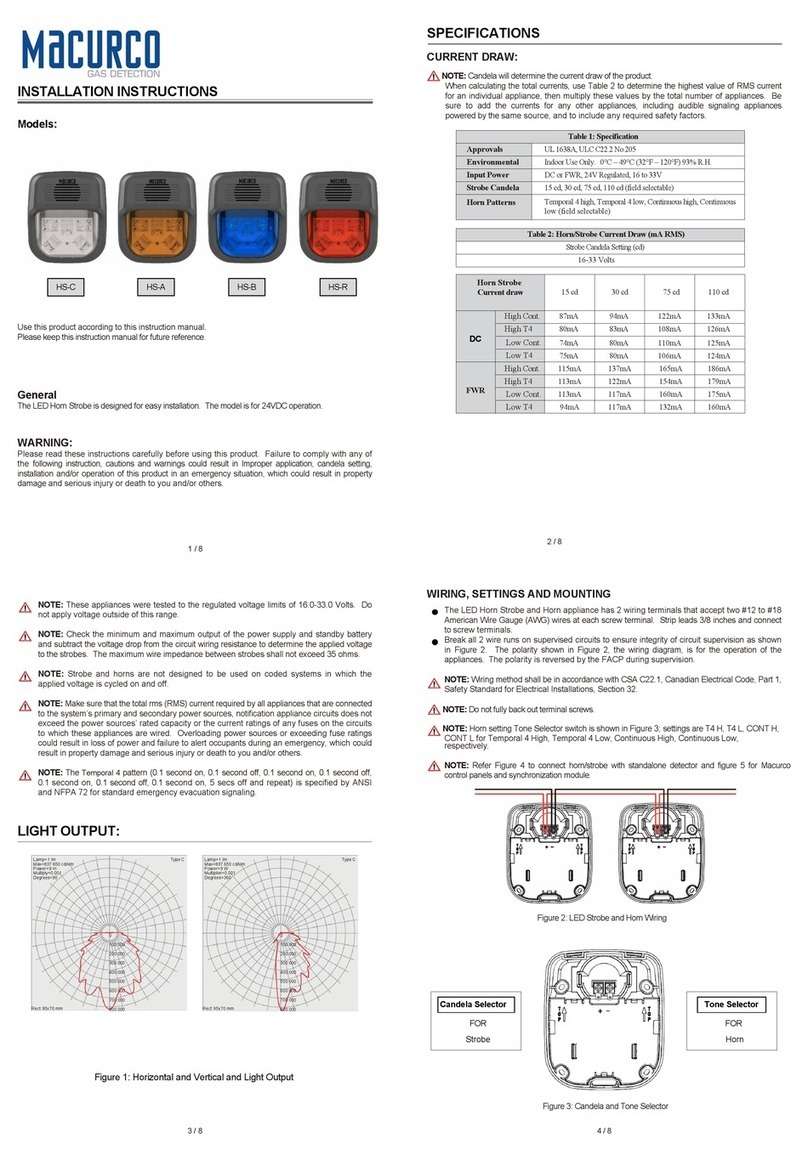
Macurco
Macurco HS-C installation instructions

Vixen Horns
Vixen Horns VXO8210/1101 installation guide

Vixen Horns
Vixen Horns VXO8350B/4124B installation guide
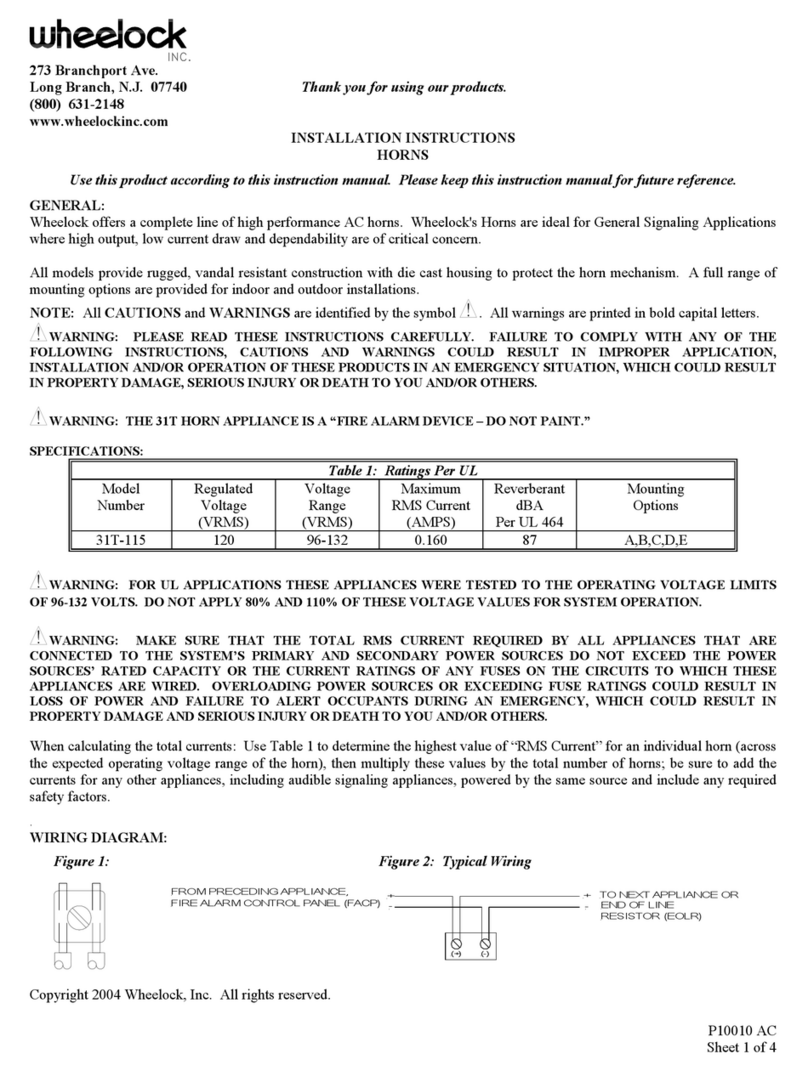
Wheelock
Wheelock 31T-115 installation instructions
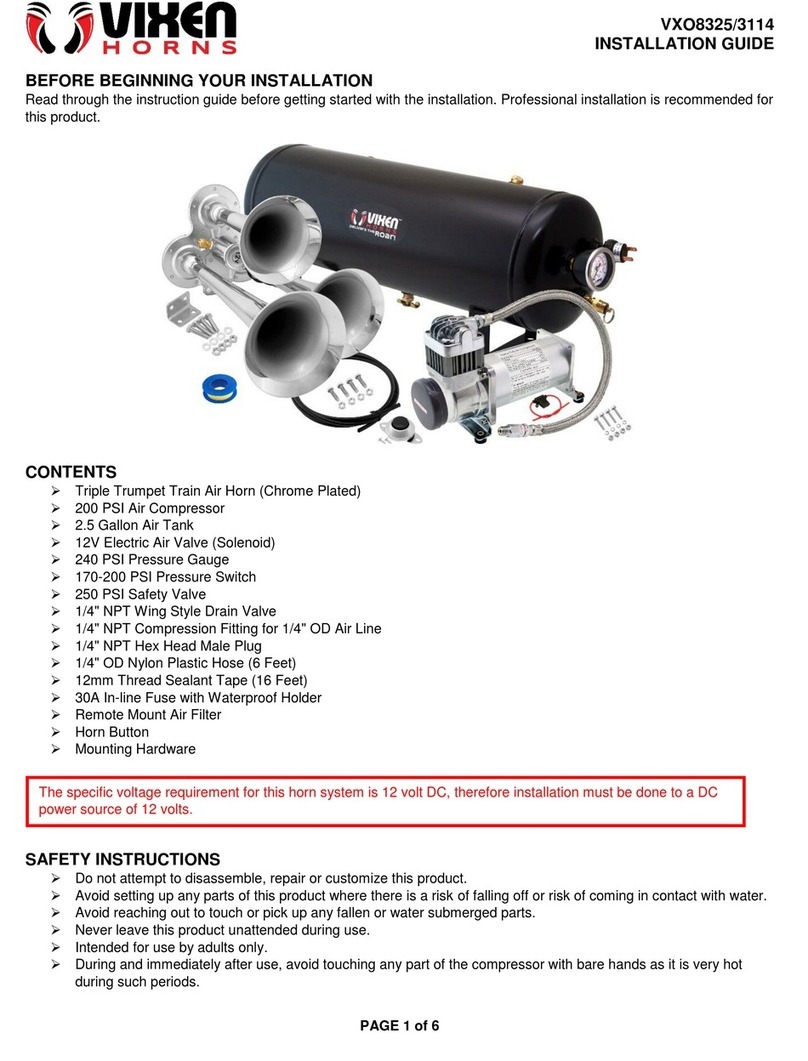
Vixen Horns
Vixen Horns VXO8325/3114 installation guide
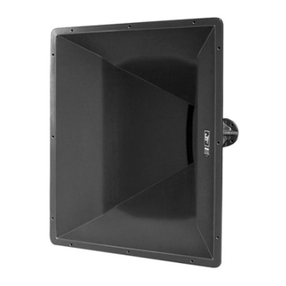
Electro-Voice
Electro-Voice HP4020 Specifications

